As someone who loves coleslaw, I know how frustrating it can be to have leftovers that go to waste. Fortunately, freezing coleslaw is a simple and effective way to preserve this delicious side dish for later use.
Whether you’re making a big batch for a party or just want to save some for later, freezing coleslaw is a great option that will help you avoid waste and keep your food budget in check.
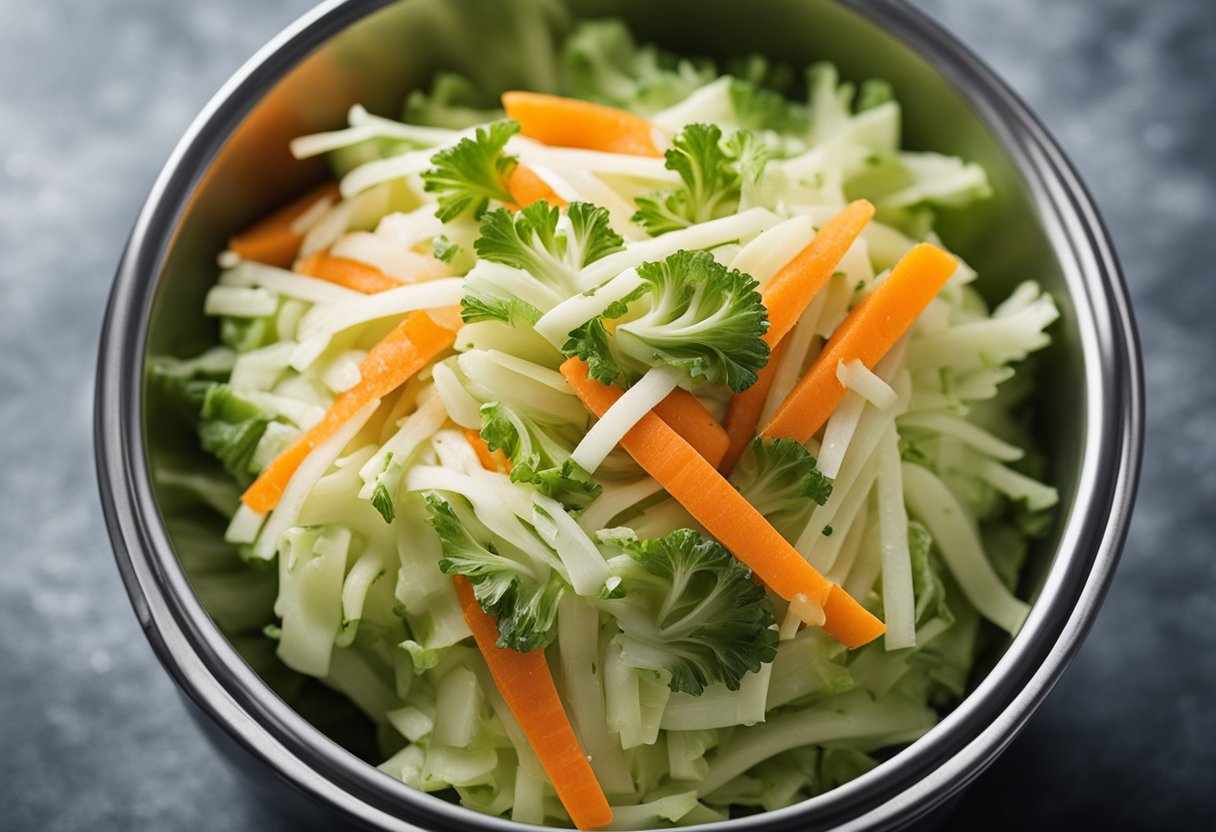
Before you start freezing coleslaw, there are a few things you need to know. First, not all coleslaw recipes are created equal when it comes to freezing. Some types of coleslaw, like those with mayonnaise-based dressings, are not well-suited to freezing.
However, coleslaw with oil and vinegar-based dressings can be frozen successfully. Additionally, there are some important steps you need to take to prepare your coleslaw for freezing, and some tips and considerations to keep in mind throughout the process.
Key Takeaways
- Freezing coleslaw is a great way to avoid waste and save money.
- Only certain types of coleslaw are well-suited to freezing.
- Proper preparation and packaging are key to successfully freezing coleslaw.
Understanding Coleslaw
As someone who loves coleslaw, I know that it can be a delicious side dish that pairs well with many meals. However, it’s important to understand the ingredients and dressing types that go into making coleslaw before attempting to freeze it.
The main ingredient in coleslaw is cabbage, which is typically shredded or thinly sliced. Other common ingredients include onion, carrot, and sometimes apple.
Coleslaw can be made with a variety of dressings, including vinegar-based, mayonnaise-based, or a combination of both.
When it comes to freezing coleslaw, the type of dressing used is important to consider. Vinegar-based coleslaw can be frozen without any issues, but coleslaw made with mayonnaise-based dressing should not be frozen.
The freezing process can affect the mayo’s chemical composition, resulting in a change in taste.
To freeze coleslaw with vinegar-based dressing, simply place the mix in a freezer bag. Remove the excess air, seal the bag, and label it.
You can now use frozen coleslaw up to 3 months when kept in the freezer. When it’s time to use the coleslaw, simply remove it from the freezer and thaw it in the fridge overnight.
If you’re looking to freeze coleslaw with a creamy dressing, there are a few steps you can take to ensure the best results.
Flash freezing the raw cabbage before adding the dressing can help maintain the texture and prevent it from becoming mushy. Additionally, investing in a food saver device that removes all the air in the package can help preserve the coleslaw’s quality.
Overall, coleslaw can be a great addition to any meal, and with the right preparation, it can be frozen for later use. Just be sure to consider the type of dressing used before attempting to freeze coleslaw.
Preparation Before Freezing
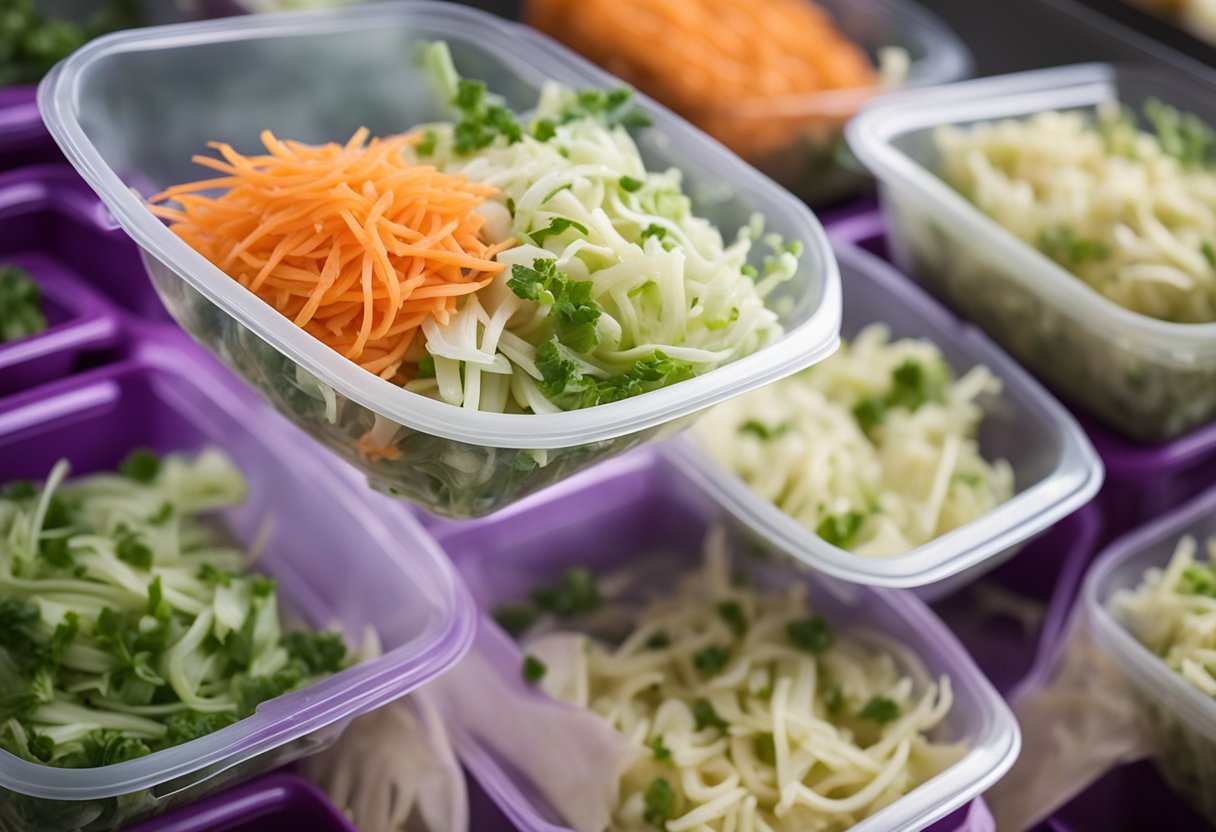
Before freezing coleslaw, it’s important to take certain steps to ensure optimal texture and flavor. Here are some tips to help you prepare your coleslaw for freezing:
Choose Fresh Ingredients
Start with fresh ingredients. Select a head of cabbage that is firm and free from any signs of wilting or discoloration. If using coleslaw mix, make sure it looks fresh and has not been sitting on the shelf for too long. Check the expiration date and make sure it hasn’t passed.
Seasoning
Season your coleslaw with salt, sugar, celery seed, pepper, mustard seed, black pepper, and/or lemon juice to taste. You can also add shredded carrots, bell pepper, or green peppers for extra flavor and nutrition.
Mix Well
Mix all the ingredients together well. Make sure that the seasoning is evenly distributed throughout the coleslaw.
Let it Sit
Let the coleslaw sit for a few minutes to allow the flavors to meld together. This will help enhance the taste of the coleslaw.
Package Properly
Package the coleslaw in airtight containers or freezer bags. Be sure to label the containers with the date and contents.
By following these steps, you can ensure that your coleslaw will freeze well and taste great when you’re ready to enjoy it.
Packaging for Freezing
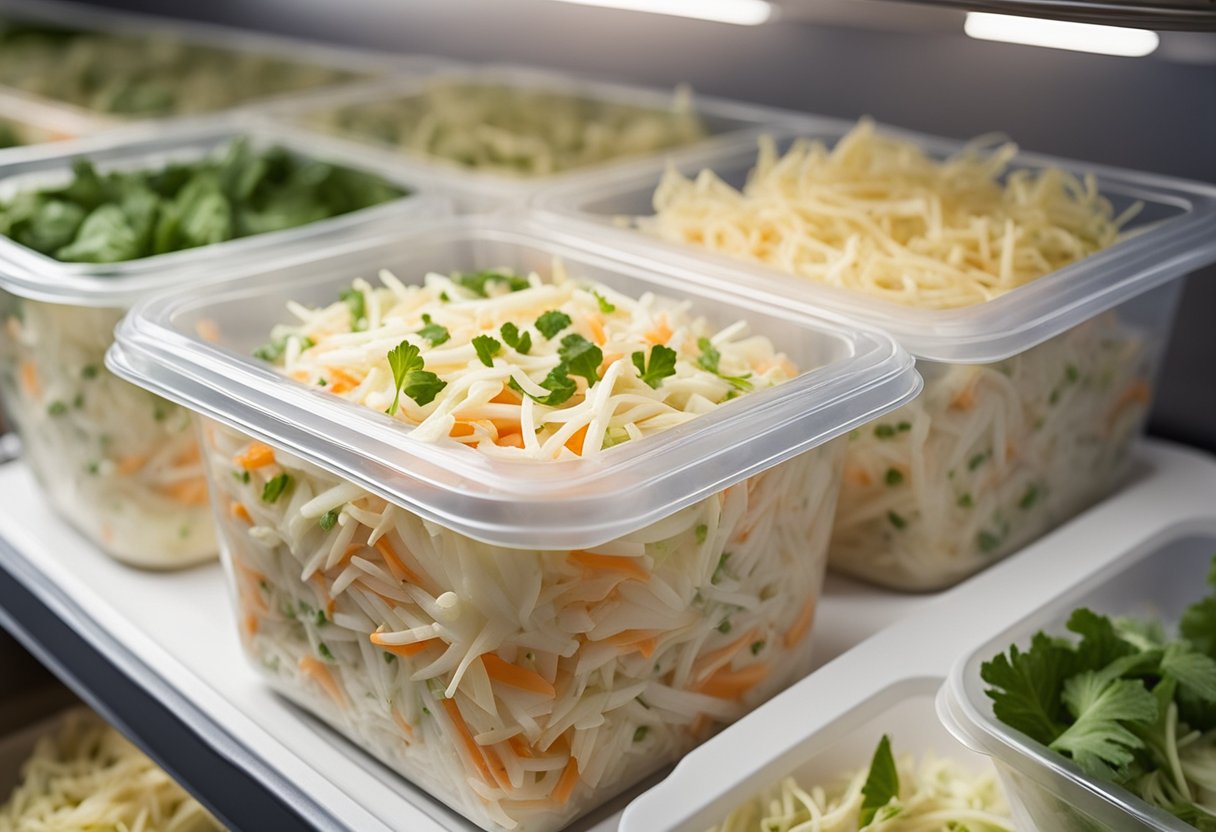
Once you have prepared your coleslaw for freezing, you need to package it properly to ensure that it stays fresh and maintains its texture. There are several options available for packaging coleslaw for freezing.
Freezer-Safe Containers
One option for packaging coleslaw for freezing is to use freezer-safe containers. These containers come in various sizes and shapes, and they are designed to withstand freezing temperatures.
They are a great option if you want to freeze large batches of coleslaw or if you have some leftover from a jar or can.
When using freezer-safe containers, make sure that they are airtight and that there is no excess air inside. This will help prevent freezer burn and keep your coleslaw fresh.
Label the containers with the date of freezing to keep track of how long they have been in the freezer.
Freezer Bags
Another option for packaging coleslaw for freezing is to use freezer bags. These bags are designed to withstand freezing temperatures and are a great option if you want to save space in your freezer. They are also a good option if you want to freeze individual portions of coleslaw.
When using freezer bags, make sure to remove as much air as possible before sealing them. This will help prevent freezer burn and keep your coleslaw fresh. Label the bags with the date of freezing to keep track of how long they have been in the freezer.
Vacuum Sealers
If you have a vacuum sealer, you can use it to package your coleslaw for freezing. Vacuum sealing removes all the air from the packaging, which helps prevent freezer burn and keeps your coleslaw fresh for longer.
When using a vacuum sealer, make sure to follow the manufacturer’s instructions carefully. Label the packages with the date of freezing to keep track of how long they have been in the freezer.
Airtight Containers
If you don’t have freezer-safe containers or freezer bags, you can use airtight containers to package your coleslaw for freezing.
Make sure that the containers are airtight and that there is no excess air inside. This will help prevent freezer burn and keep your coleslaw fresh.
Label the containers with the date of freezing to keep track of how long they have been in the freezer.
Overall, packaging coleslaw for freezing is easy and straightforward. Just make sure to use freezer-safe containers, freezer bags, vacuum sealers, or airtight containers to maintain the freshness and texture of your coleslaw.
The Freezing Process
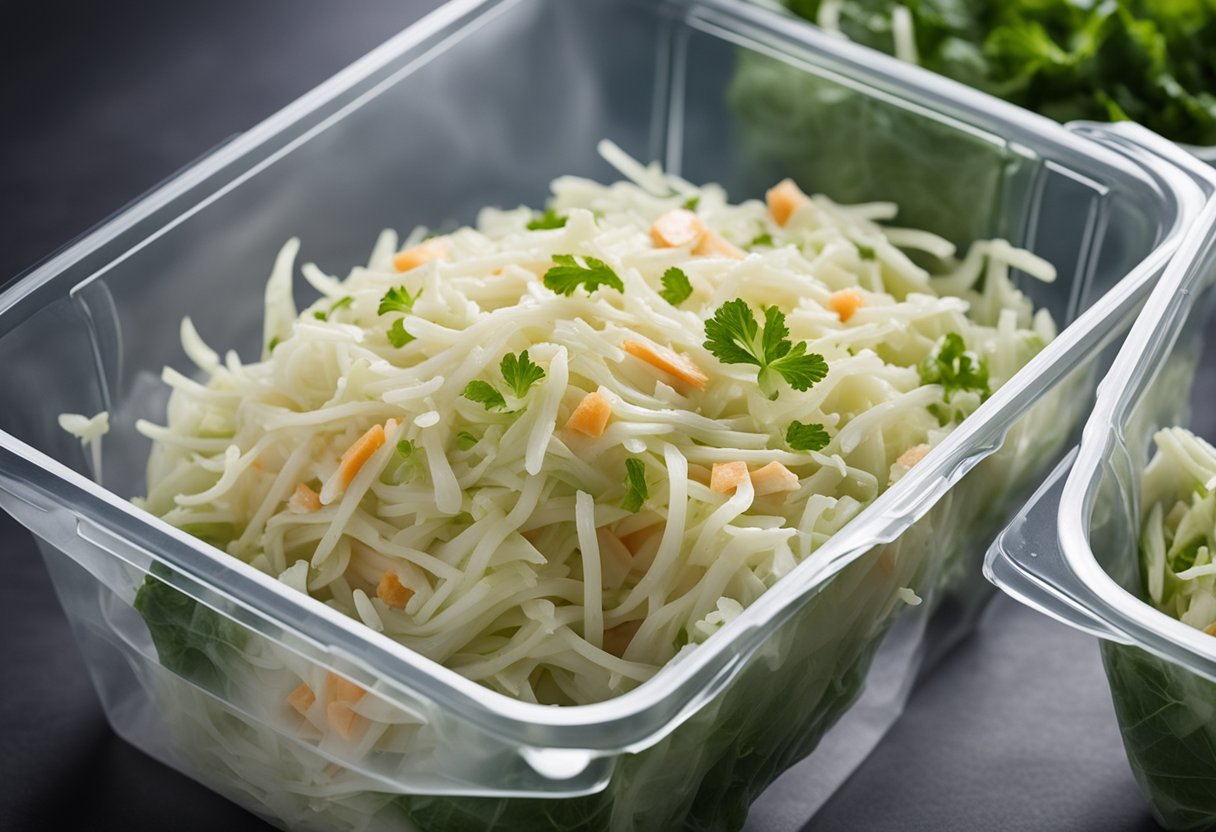
Freezing coleslaw is an excellent way to preserve it for future use. The process is simple and straightforward.
Here are the steps to follow:
- Prepare the coleslaw as you would normally.
- If you are using a vinegar-based dressing, simply place the mixture in a freezer bag. Be sure to remove any excess air before sealing the bag. Label the bag with the date and contents.
- If you are using a mayo-based dressing, you may want to consider freezing the cabbage and dressing separately. This will help prevent the dressing from separating and becoming watery upon thawing. To do this, place the cabbage in a freezer bag and the dressing in a separate container. Label both with the date and contents.
- Place the bag or container in the freezer. Be sure to lay it flat so that it freezes evenly.
- When you are ready to use the coleslaw, remove it from the freezer and thaw it in the refrigerator overnight.
It’s important to note that freezing coleslaw can affect its texture. The freezing and thawing process can break down the cellular structure of the cabbage, resulting in a softer texture. Additionally, the flavor may be slightly altered after thawing.
Overall, freezing coleslaw is a great way to extend its shelf life and reduce food waste. With a little bit of preparation, you can enjoy fresh-tasting coleslaw all year round.
Thawing and Using Frozen Coleslaw
After freezing coleslaw, it’s important to thaw it properly before using it. Here are some tips for thawing and using frozen coleslaw:
- Thawing in the fridge: The safest way to thaw frozen coleslaw is by placing it in the fridge overnight. This allows the coleslaw to thaw slowly, which helps to maintain its texture and flavor. Once thawed, you can use the coleslaw as you normally would.
- Thawing at room temperature: If you’re in a hurry, you can thaw frozen coleslaw at room temperature. However, this method can be risky as it can promote bacterial growth. To thaw at room temperature, place the coleslaw in a bowl and let it sit on the counter for a few hours. Make sure to stir it occasionally to promote even thawing.
- Using leftovers: If you have leftover coleslaw that has been thawed, it’s important to use it within a few days. Leftovers should be stored in an airtight container in the fridge.
- Using frozen coleslaw: Frozen coleslaw can be used in a variety of dishes, including tacos, sandwiches, and as a side dish for main dishes and grill staples. To use frozen coleslaw, simply thaw it using one of the methods mentioned above and then mix it with your desired dressing.
Overall, freezing coleslaw is a great way to extend its shelf life and reduce waste. By following these tips for thawing and using frozen coleslaw, you can ensure that your coleslaw is safe to eat and delicious.
Tips and Considerations
When it comes to freezing coleslaw, there are a few tips and considerations to keep in mind. These tips will help ensure that your coleslaw retains its texture and taste after being frozen and thawed.
Texture and Taste
One of the biggest concerns when freezing coleslaw is the potential for it to lose its texture and taste. To help prevent this, it’s important to choose the right type of coleslaw to freeze.
Coleslaw with a vinegar-based dressing tends to freeze better than coleslaw with a mayonnaise-based dressing. This is because mayonnaise can separate and become watery when frozen.
Another way to help preserve the texture and taste of coleslaw is to avoid freezing it for too long. Coleslaw that is frozen for an extended period of time may become mushy or lose its flavor.
Leftover Coleslaw
If you have leftover coleslaw that you want to freeze, it’s important to keep in mind that coleslaw that has already been dressed may not freeze as well as undressed coleslaw.
If possible, freeze undressed coleslaw and add the dressing after it has been thawed.
Cooked Dish
Coleslaw can also be used in cooked dishes, such as casseroles or stir-fries. If you plan to use frozen coleslaw in a cooked dish, it’s important to thaw it completely before adding it to the dish. This will help ensure that the coleslaw cooks evenly and retains its texture.
Food Safety
When freezing coleslaw, it’s important to follow proper food safety guidelines. Make sure to wash your hands and any utensils or containers that will come into contact with the coleslaw.
Additionally, make sure to label and date the coleslaw before freezing it, and only freeze coleslaw that is fresh and has not been sitting out at room temperature for an extended period of time.
Tips and Freezing Guide
To freeze coleslaw, start by preparing the coleslaw and dressing. Combine the cabbage and dressing, and portion the coleslaw into airtight containers or freezer-safe plastic bags.
Remove excess air and label and date the packages before freezing. Coleslaw can be frozen for up to three months.
Trust the Process
Freezing coleslaw can be a great way to save time and reduce food waste. By following these tips and considerations, you can help ensure that your coleslaw retains its texture and taste after being frozen and thawed.
Trust the process and enjoy your frozen coleslaw whenever you’re ready to eat it!
Coleslaw Variations

When it comes to coleslaw, there are a variety of different variations that you can try. Some of these variations include:
Mayo-Based Coleslaw
Mayo-based coleslaw is a classic version of coleslaw that is often served at picnics and barbecues. This type of coleslaw is made with a mayonnaise-based dressing that gives it a creamy texture and a tangy flavor.
If you’re planning on freezing coleslaw, you should avoid using mayo-based dressing as it does not freeze well and tends to separate after being frozen.
Vegan Proteins
If you’re looking for a way to add some protein to your coleslaw, there are a variety of vegan options that you can try. Some popular vegan proteins include tofu, chickpeas, and tempeh.
These options are not only high in protein, but they also add a unique flavor and texture to your coleslaw.
Cabbage Casserole
Cabbage casserole is a unique twist on traditional coleslaw. This dish is made by layering shredded cabbage with a variety of other ingredients, such as cheese, breadcrumbs, and spices.
The dish is then baked in the oven until it is golden brown and crispy. This is a great option if you’re looking for a warm and comforting side dish.
KFC Coleslaw
KFC coleslaw is a popular version of coleslaw that is served at the fast-food chain. This coleslaw is made with a sweet and tangy dressing that is made from a combination of vinegar, sugar, and mayonnaise.
If you’re looking to recreate this dish at home, you can find a variety of copycat recipes online.
Fiber
Coleslaw is a great source of fiber, which is important for maintaining a healthy digestive system. Adding ingredients like carrots, celery, and broccoli to your coleslaw can increase the fiber content and make it even more nutritious.
In conclusion, there are a variety of different coleslaw variations that you can try. Whether you’re looking for a classic mayo-based coleslaw or a unique twist on traditional coleslaw, there is a recipe out there for everyone.
Just make sure to avoid using mayo-based dressing if you plan on freezing your coleslaw.
Frequently Asked Questions
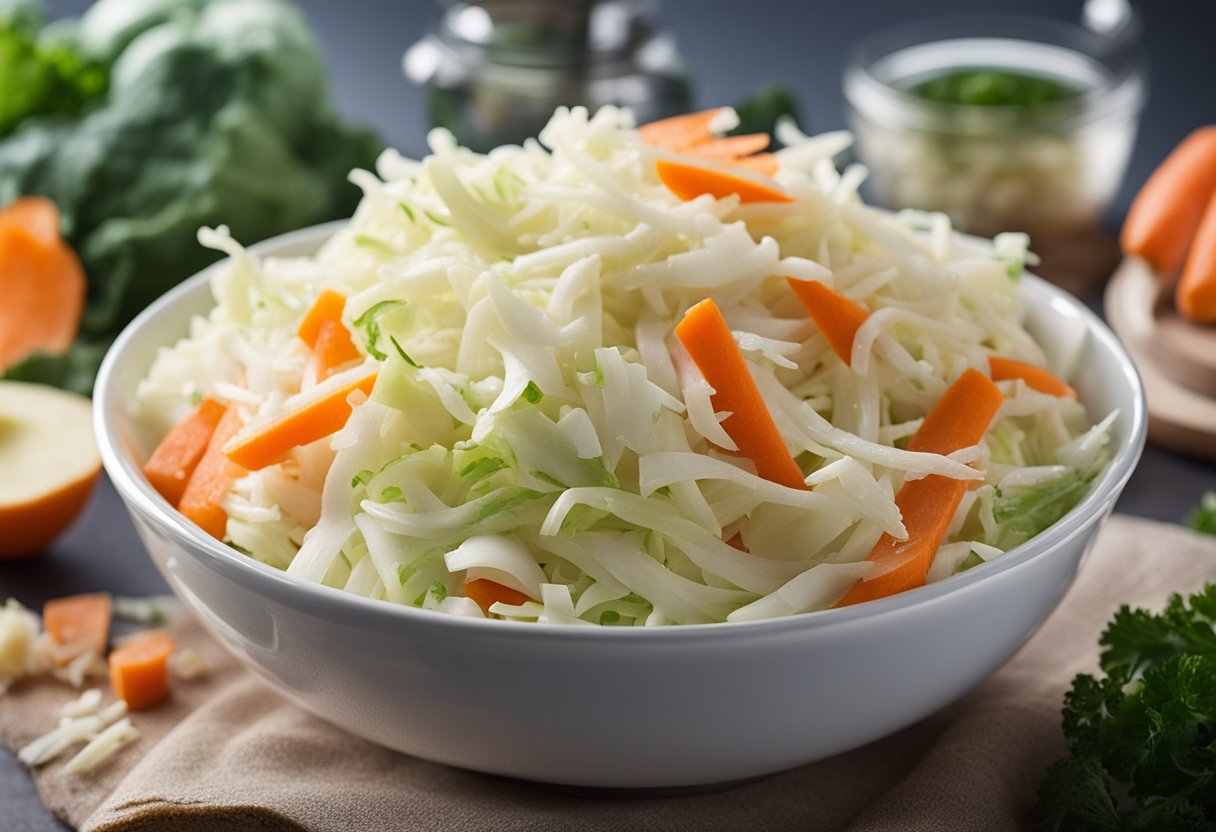
Can coleslaw be frozen?
Yes, coleslaw can be frozen. However, it is important to note that the texture and flavor may be affected after thawing.
It is recommended to freeze coleslaw made with vinegar-based dressing as mayo-based dressings may separate and become watery.
What is the best way to freeze coleslaw?
The best way to freeze coleslaw is to place it in a freezer-safe container or freezer bag. Remove the excess air, press the coleslaw flat, and seal the bag. Label and date the coleslaw and freeze. It can be stored stacked in the freezer.
Can you freeze coleslaw made with yogurt?
It is not recommended to freeze coleslaw made with yogurt as the texture may change and become watery.
Can you freeze coleslaw mix?
Yes, you can freeze coleslaw mix. Follow the same freezing instructions as you would for regular coleslaw.
How to defrost frozen coleslaw?
To defrost frozen coleslaw, remove it from the freezer and thaw it in the fridge overnight. You can also thaw it at room temperature for a few hours, but this method is not recommended as it may cause the coleslaw to become watery.
Is it safe to freeze chopped cabbage for coleslaw later?
Yes, it is safe to freeze chopped cabbage for coleslaw later. Follow the same freezing instructions as you would for regular coleslaw.







